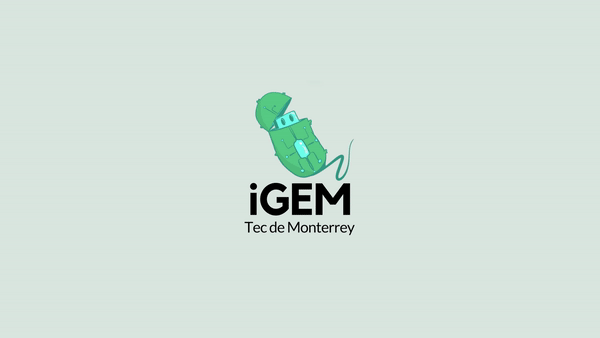| Line 145: | Line 145: | ||
In the bateria, five precursor species were identified as the ones relevant for the system. These precursors are precisely Cas1 protein, Cas2 protein, the msr-msd (UM from ‘unprocessed message’), the retrotranscriptase (RT) protein, and IPTG (I from 'inductor'). The first four species are produced by IPTG regulated transcription, which has some advantages, mainly the fact that the bacteria is not able to metabolize it, so its concentration does not change. | In the bateria, five precursor species were identified as the ones relevant for the system. These precursors are precisely Cas1 protein, Cas2 protein, the msr-msd (UM from ‘unprocessed message’), the retrotranscriptase (RT) protein, and IPTG (I from 'inductor'). The first four species are produced by IPTG regulated transcription, which has some advantages, mainly the fact that the bacteria is not able to metabolize it, so its concentration does not change. | ||
<div class="body-subtitle">Protein expression</div> | <div class="body-subtitle">Protein expression</div> | ||
| + | <b>Production</b><br><br> | ||
Research on IPTG induction in our plasmid led us to the Hill equation, an expression that is simple, practical and commonly used in regulated protein production modeling. | Research on IPTG induction in our plasmid led us to the Hill equation, an expression that is simple, practical and commonly used in regulated protein production modeling. | ||
| − | <br>It is well known that the induction stimulates the transcription of RNA which then is translated by the ribosomes into proteins. So, the Hill equation is valid when it is assumed that, as soon as the RNA is produced, it is immediately processed and translated into the corresponding proteins by the bacteria.This means that all these four species are able to be modeled by the Hill equation. | + | <br><br>It is well known that the induction stimulates the transcription of RNA which then is translated by the ribosomes into proteins. So, the Hill equation is valid when it is assumed that, as soon as the RNA is produced, it is immediately processed and translated into the corresponding proteins by the bacteria.This means that all these four species are able to be modeled by the Hill equation. |
| − | <br>An important thing to consider is the native production of these proteins by the bacteria. Although it is expected that this basal production is insignificant when compared to the IPTG regulated production, the use of this basal production increases the accuracy in which the insertions are related to the inductor concentrations. | + | <br><br>An important thing to consider is the native production of these proteins by the bacteria. Although it is expected that this basal production is insignificant when compared to the IPTG regulated production, the use of this basal production increases the accuracy in which the insertions are related to the inductor concentrations. |
<div class="body-subtitle">Complex formation</div> | <div class="body-subtitle">Complex formation</div> | ||
<div class="body-subtitle">Complex interactions</div> | <div class="body-subtitle">Complex interactions</div> | ||
Revision as of 16:01, 17 October 2018





Mathematical Model
E. coding description
Introduction
The description of our system had a progressive development parallel to the realization of the whole project. Initially, a simple system of linear coupled differential equations was proposed to describe the whole system, but as the understanding of all the aspects the system involves improved, the model was continuously refined to encompass a more suitable description that became both accurate and practical.
Biological System
Biological systems modeling is the creation of a kinetics diagram that connects all the important species of the system through relationships that represent bio-chemical reactions.
In the case of the E. coding system, the methodology consisted in:
- The identification of each individual component
- Consulting literature on the possible interactions
- Creating a kinetic diagram
- Establishing the whole differential equations system via biochemical reactions and the eventual message insertion inside our bacteria
Identification
In the bateria, five precursor species were identified as the ones relevant for the system. These precursors are precisely Cas1 protein, Cas2 protein, the msr-msd (UM from ‘unprocessed message’), the retrotranscriptase (RT) protein, and IPTG (I from 'inductor'). The first four species are produced by IPTG regulated transcription, which has some advantages, mainly the fact that the bacteria is not able to metabolize it, so its concentration does not change.
Protein expression
ProductionResearch on IPTG induction in our plasmid led us to the Hill equation, an expression that is simple, practical and commonly used in regulated protein production modeling.
It is well known that the induction stimulates the transcription of RNA which then is translated by the ribosomes into proteins. So, the Hill equation is valid when it is assumed that, as soon as the RNA is produced, it is immediately processed and translated into the corresponding proteins by the bacteria.This means that all these four species are able to be modeled by the Hill equation.
An important thing to consider is the native production of these proteins by the bacteria. Although it is expected that this basal production is insignificant when compared to the IPTG regulated production, the use of this basal production increases the accuracy in which the insertions are related to the inductor concentrations.
Complex formation
Complex interactions
Insertion
Differential Equations System
Kinetic diagram
Equations
Parameters
Modified Quasi-Steady State Approximation
Equations
Parameters
Protein Production characterization
Protein Production Model
Equations
Parameters
Predictions
Sudden bulk induction
Expression
Insertions
Initial conditions expansion
Industry induction
Expression
Insertions
Initial conditions expansion


